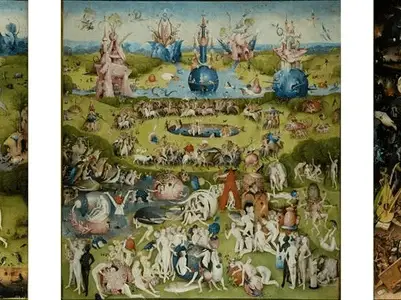Title of Artwork: “The Garden of Earthly Delights”

Artwork by Hieronymus Bosch
Year Created 1510 – 1515
Summary of The Garden of Earthly Delights
Oil on wood panel triptych by Early Netherlandish master Hieronymus Bosch, known as The Garden of Earthly Delights after its 1939 acquisition by the Museo del Prado in Madrid. Between 1490 and 1510, while Bosch was between the ages of 40 and 60, he created this piece.
Since so little is known about Bosch’s life or motivations, interpretations of his aim have varied widely, from a warning against giving in to worldly fleshly excess to an evocative of transcendent sexual pleasure. Scholars have come to different conclusions on the meaning of its symbols over the years due to the complexity of the central panel.
There is some debate among art historians of the 20th century as to whether the centre panel of the triptych is meant to serve as a cautionary tale or a vision of paradise lost. An “erotic aberration that turns us all into voyeurs,” as Peter S. Beagle puts it, “a place replete with the enticing air of absolute liberty.”
All About The Garden of Earthly Delights
Each panel in Bosch’s three monumental triptychs (the others being The Last Judgment from around 1482 and The Haywain Triptych from around 1516) is vital to understanding the meaning of the whole. There are common threads amongst these pieces, including history and religious belief, yet each one stands on its own.
The central panel of a triptych from this time period often depicted the main subject, while the left and right panels depicted either Eden or the Last Judgment, respectively, and were meant to be read consecutively.
Although the original purpose of “The Garden” is unknown, it is widely believed that the painting was not commissioned by a religious institution and was instead inspired by the severe subject matter of the central and right panels.
The outer panels’ design is revealed when the triptych’s wings are shut. These panels are painted in a greenish-grey grisaille, as were other Netherlandish triptychs, but the lack of colour may suggest that they depict a period before the formation of the sun and moon, which were said to have been created by God to “give light to the earth.”
Typically, the exterior panels of Netherlandish altarpieces were painted in grisaille to draw attention to the rich colouration found within.
The outer panels, which portray vegetation gradually covering a still-bare Earth, are commonly interpreted as depicting the genesis of the world. On the far left, a tiny figure wearing a crown reminiscent of a papal tiara (a standard convention in Netherlandish painting) suggests the presence of God.
God, portrayed by Bosch as a fatherly figure, is shown sitting passively with a Bible on his lap as he creates the world. Psalm 33:6 reads over his head: “Ipse dixit, et facta sunt: ipse mandvit, et creta sunt.”
Because when he spoke, things moved swiftly and decisively; when he gave orders, they held. One can’t help but be reminded of the classic image of the world as a crystal sphere held by God or Christ as they create the universe and see the Earth enclosed within a transparent sphere.
It dangles in the void of space, which represents the cosmos and is inhabited only by God.
Information Citations:
En.wikipedia.org, https://en.wikipedia.org/.























